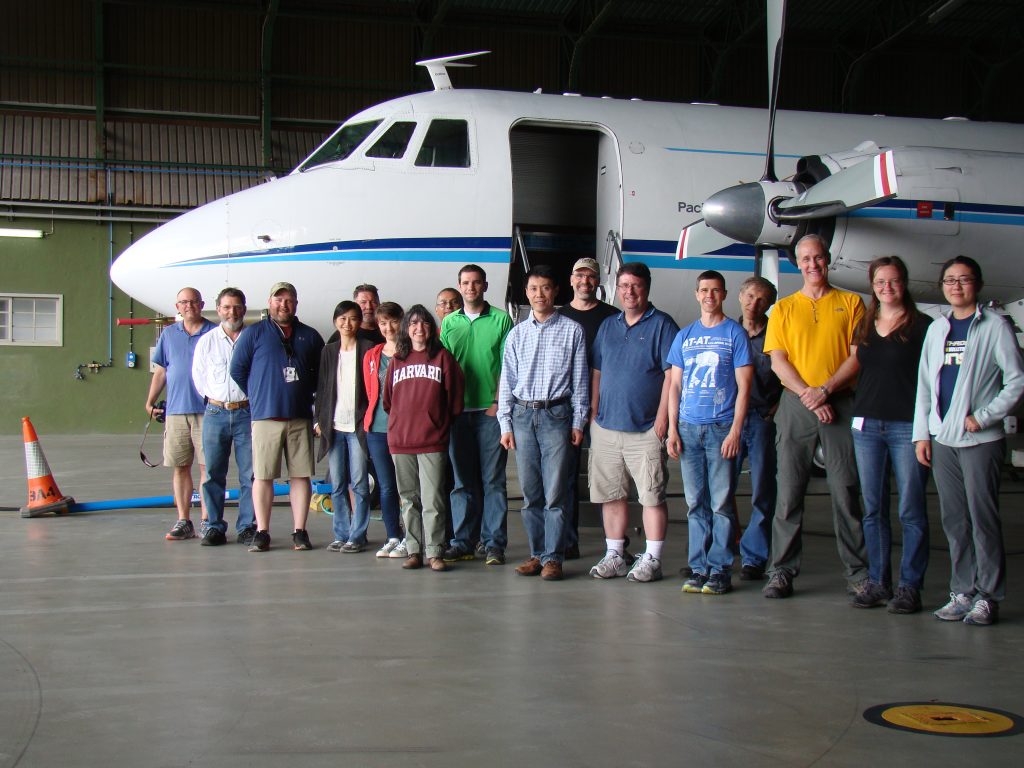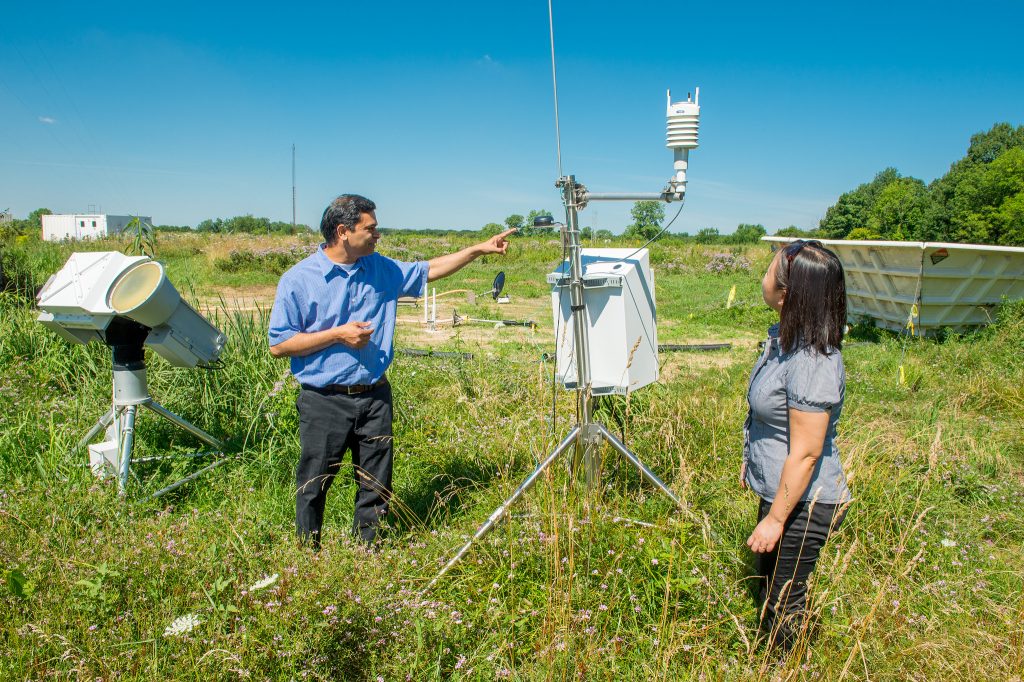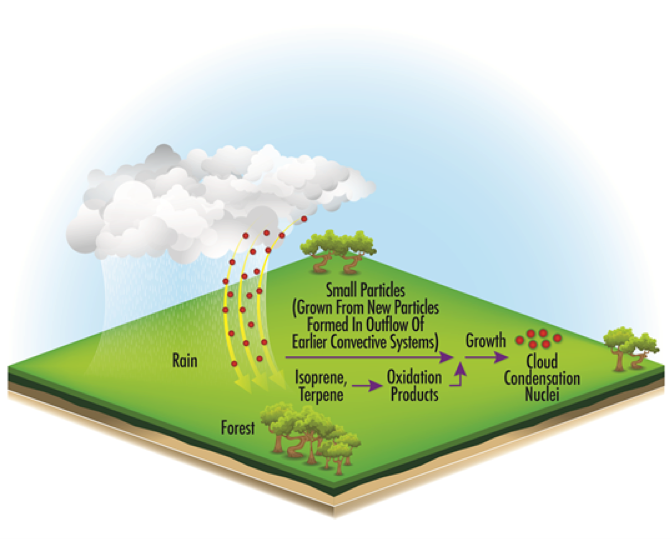The two-lab, multi-partner effort includes a strong collaboration between experimentalists and modelers

Clouds in all their forms are familiar, but scientists still grapple with understanding the processes that influence their shapes, sizes, and life cycles.
These vastly consequential bodies of ice and water hold and dispense rain and snow, cast shadows from the sun, and blanket the Earth. Aerosols, the particles that help clouds form, are swept up from the surface and elsewhere.
But how do clouds and aerosols interact? What are the small-scale processes that drive those interactions, and how can they be predictively modeled?
Help is on the way in the form of a three-year science focus area (SFA) project renewed in fall 2017 by the Atmospheric System Research (ASR) program at the U.S. Department of Energy (DOE). Its principal collaborators are experimentalists from Brookhaven National Laboratory (BNL) in New York and computer modelers from Argonne National Laboratory (ANL) in Illinois.
“The ultimate goal of all our research is to improve weather and climate models,” says BNL meteorologist Michael P. Jensen. “We’re aiming to improve our understanding of some of the processes that contribute most to the uncertainty in model simulations.”
He is the SFA’s laboratory research manager, along with co-managers V. Rao Kotamarthi (ANL) and Robert L. McGraw (BNL). In all, the SFA supports the participation of 22 BNL and ANL researchers, whose efforts are spread over different project components.
The Power of Past Work

Starting in 2009, the SFA’s two previous iterations generated a number of well-regarded papers, including studies on the theory and observation of the transition from cloud to drizzle particles; the observation of supercooled liquid in mixed-phase clouds using radar Doppler spectra; and the vertical transport of aerosols in the Amazon boundary layer during rainfall events, a 2016 Nature offering.
BNL has already had important impacts on our understanding of cloud-aerosol interactions, says Jensen. The lab pioneered the use of radar Doppler spectra measurements to extract insights on cloud properties and processes. Scientists there also developed novel ways of measuring new particle formation, down to nuclei as small as one nanometer across.
BNL also led efforts to determine the factors that impact the formation of cloud condensation nuclei (CCN), the interaction between these particles and clouds, and the representation of these processes in models.
Joining the BNL and ANL collaborators—largely on the modeling side—are partners from Stony Brook University in New York, the NASA Goddard Institute for Space Studies, and the Geophysical Fluid Dynamics Laboratory at the National Oceanic and Atmospheric Administration.
For the first time, ANL will assume a role in the SFA, adding a layer of modeling expertise. “We saw it as a benefit to both teams,” says Jensen.
“We get access to their data, and they get access to our models,” says Kotamarthi. “It’s a great collaboration. We really hope we get to some of the central questions of aerosol-cloud interactions in the next several years.”
Absorbing and Scattering Light
The SFA’s aerosol investigators are trying to better understand the evolution of light-absorbing aerosol particles, and how they interact with incoming solar radiation.
Changes in the chemical and microphysical properties of particles alter how they absorb or scatter light. The science of those particle changes “is a very hot topic these days,” says BNL’s Arthur J. Sedlacek.
Of special interest is how these interactions with light change as particles age.
Light-absorbing organic aerosols, such as those produced in wildfires, can become less light absorbing as they age in the atmosphere. Understanding the “bleaching” effect that aging has on particles will better inform future models.
Sedlacek says one data set from the DOE Atmospheric Radiation Measurement (ARM) Climate Research Facility is especially important to understand this aging process: 2013’s Biomass Burning Observation Project (BBOP). That field campaign used the ARM Aerial Facility and its Gulfstream-159 (G-1) research aircraft. (Sedlacek and BNL SFA collaborator Lawrence Kleinman were BBOP’s co-principal investigators.)
Aircraft-based research gives a scientist the ability to probe how the particles within a plume of smoke age as they advect downwind from the source of burning. At a research sampling speed of 100 meters per second, such flights can easily capture the dynamics of aerosol aging.
Sedlacek is the SFA’s technical lead for investigating how particles absorb and scatter light. It’s a very difficult task, he says. “Aerosols are not static. Their properties change, unlike CO2 in the atmosphere. That’s what makes the problem challenging.”

Aerosol investigators within the SFA are also looking at the formation, growth, and removal of atmospheric aerosols. That includes studying the relative importance of particle formation aloft as a source of new particles at the surface.
Another area of investigation is how “neutral clusters” contribute to the population of nucleated particles, a phenomenon being studied by BNL’s Chongai Kuang. At condensation sites, these clusters can influence early particle growth rates, as well as the final concentration of particles nucleated from trace atmospheric vapors.
Clouds: Big and Small, Thick and Thin
The SFA’s cloud investigators focus on processes that determine cloud life cycles and radiative impacts. This includes looking at how turbulent mixing and so-called “giant CCN” influence the formation of precipitation in shallow clouds over the ocean, and how the feedbacks between precipitation and clouds drive their mesoscale organization.
For deeper clouds, the SFA aims to close knowledge gaps related to cloud organization, vertical velocities, and the heating profile associated with clouds. As water changes to vapor and then to ice within clouds, the resulting heating and cooling dynamics can drive further circulation in ways not yet well understood.
And for arctic clouds, SFA researchers will focus on the dynamical and microphysical processes that determine the partitioning of liquid and ice in the clouds, which are important factors in determining their radiative impacts.
Go-to Data
SFA researchers are using data from ARM’s fixed sites, mobile observatories, and aircraft. To Jensen, the most impactful data sets in the next three years will come from three ARM field campaigns: Aerosol and Cloud Experiments in the Eastern North Atlantic (ACE-ENA); the ARM West Antarctic Radiation Experiment (AWARE); and Green Ocean Amazon (GoAmazon2014/15).

Add another to that list, says Kotamarthi: Layered Atlantic Smoke Interactions with Clouds (LASIC), which is a systematic study of smoke from West African fires as it drifts across the Atlantic and introduces perturbations into clouds.
“Wildfires across the globe will increase,” says Kotamarthi. “It’s a kind of background emission we have to pay attention to.”
At ANL, Kotamarthi will work on higher resolution models of how aerosol processes couple to clouds. Joining him will be atmospheric and climate scientist Yan Feng and postdoctoral researcher Ryan Sullivan.
Aiming for Higher Resolutions
The SFA will augment all this data with improved instrumentation, advanced data-retrieval techniques, laboratory experiments, and modeling studies that achieve higher resolution.
It helps that computing power has come a long way, says Kotamarthi. High-resolution models of a 4-kilometer grid cell or less can now be run to simulate likely changes over a hundred years. Less than a decade ago, it was difficult to run models showing a simulated span of just two weeks.
Boosts in computational power come from DOE’s Advanced Scientific Computing Research facilities, where users can get millions of hours of computing time. In five years or so, exascale computing will boost computational power even more, says Kotamarthi, “by a factor of 10, easily.”
The cloud-aerosols SFA takes advantage of the convergence of modeling activities “with the scales of the measurements we are making,” says Jensen. “That’s what makes the science we are doing possible.”
# # #
This work was supported by the U.S. Department of Energy’s Office of Science, Office of Biological and Environmental Research as part of the Atmospheric System Research Program.

